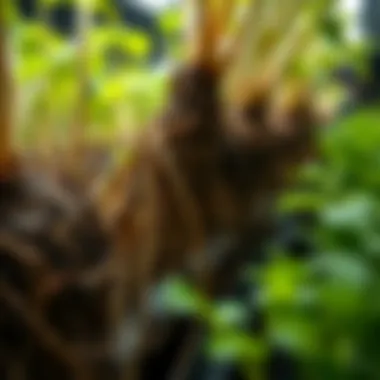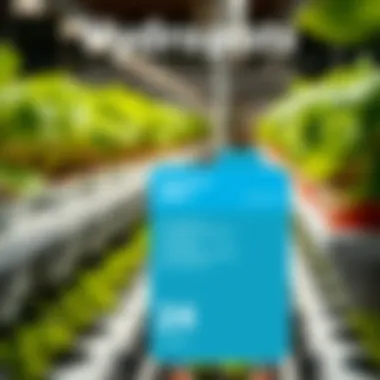Hydroponic Vase Plants: Sustainable Home Gardening


Intro
In the evolving realm of home gardening, hydroponic vase plants have emerged as a fresh alternative, offering a sustainable twist to our green-thumb pursuits. The allure of hydroponics lies in its ability to cultivate plants without soil, allowing clean and efficient growth. As urban living spaces tighten in size, the innovation of hydroponic systems brings nature closer to our homes, making it not just a hobby but a lifestyle choice that aligns with eco-friendly practices.
Exploring this modern approach reveals practical applications and benefits that cater to both the seasoned gardener and newcomers to the scene. Here, we unravel the essential techniques for nurturing hydroponic vase plants, highlighting plant selection and care methods that play a crucial role in this soil-less journey. With a focus on integrating these systems into everyday living spaces, we aim to guide readers towards adopting sustainable practices that not only beautify their surroundings but also contribute positively to the environment.
This article serves as a comprehensive guide, where we will dissect the nuances of hydroponic gardening, investigate its environmental advantages, and provide insights that resonate with anyone eager to explore a greener lifestyle.
Understanding Hydroponics
Hydroponics is more than just growing plants without soil; it’s a thriving method that deserves attention for anyone keen on sustainable gardening. As urban spaces expand and soil quality deteriorates, understanding hydroponics makes perfect sense. It offers a way to grow food efficiently, even in the most compact locations. The beauty of hydroponics is that you aren’t merely providing plants with nutrients; you’re also engaging in an eco-friendly practice that uses less water and space.
Definition and Principles
Hydroponics is a method where plants grow in a nutrient-rich water solution. Instead of relying on soil for growth, the water provides everything they need. This practice can dramatically reduce the amount of water used—often by as much as 90% compared to traditional methods. Furthermore, since roots are directly exposed to the nutrient solution, plants can absorb nutrients more effectively. To say the least, hydroponics redefines how we think about gardening.
A key principle of hydroponics is the ability to control the growing environment. Growers can tweak nutrient levels, pH, and even lighting conditions to optimize plant growth. The climate in a controlled hydroponic system is often more consistent than in traditional soil gardening, leading to healthier crops and faster growth. It’s not just a modern twist on old methods; it’s a revolutionary approach that considers the challenges that come with today’s agricultural demands.
Types of Hydroponic Systems
Choosing the right hydroponic system depends on various factors like space available, budget, and what types of plants you want to cultivate. Let’s take a closer look at a few systems that have become quite popular in the hydroponics community.p>
Deep Water Culture
Deep Water Culture (DWC) is one of the simplest and most effective hydroponic systems available. In this system, plants are suspended in a nutrient solution in a reservoir. The oxygen they need comes from air stones or other means to keep the water oxygenated. This system is popular mainly for its ability to facilitate rapid plant growth.
One unique feature of DWC is that it’s quite forgiving for beginners. The plants essentially “float” in the water, allowing for quick access to nutrients and oxygen. However, if not monitored, it can lead to problems—like root diseases if oxygen levels drop. Despite that risk, its relatively low maintenance and high success rate make it a solid choice for anyone getting their feet wet in hydroponics.
Nutrient Film Technique
The Nutrient Film Technique (NFT) employs a continuous stream of nutrient-rich water that flows over the roots of plants. This thin film of water provides optimal nutrient absorption while keeping the roots well-oxygenated. NFT is especially suited for fast-growing, shallow-rooted plants like lettuce and herbs.
What makes NFT a favored choice is its efficient use of water and nutrients. The recirculation of the water makes it an environmentally conscious option. However, the system is sensitive to interruptions; if the pump fails, the plants quickly suffer. The need for careful monitoring may deter some, but its water-saving capabilities can be a strong incentive for eco-minded individuals.
Drip Systems
Drip systems operate by slowly delivering nutrient solution directly to the plant roots. This system is versatile and can be configured for a range of plants. Whether you're growing tomatoes or strawberries, a drip system can be an adjustable ally.
The main advantage of this system is its adaptability. It’s capable of working in various settings, from indoor gardens to larger-scale operations. However, it does require a bit more setup and maintenance than some other hydroponic systems. Clogs in the drip tape can be an issue, but routine monitoring can mitigate many potential problems.
Flood and Drain Systems
Flood and Drain systems, often known as Ebb and Flow, function by periodically flooding the grow bed with nutrient solution, then draining it away. This allows plant roots to take in nutrients and oxygen alternately. It’s akin to giving your plants a refreshing drink followed by a dry period, and they thrive on that schedule.
This system's versatility allows for a multitude of plant varieties, which is one of its key strengths. The challenge here lies in ensuring that the pump is functioning smoothly and the timing for flooding and draining is correctly set. If something goes awry, it can drown the plants, but with proper monitoring, it yields impressive results.
In summary, each of these hydroponic systems offers distinct advantages tailored for various needs and plant types. Understanding these options equips aspiring gardeners with the knowledge they need to make informed decisions about their hydroponic ventures.
The Aesthetic Appeal of Hydroponic Vase Plants
Hydroponic vase plants aren’t just about growing food without soil; they’re also about elevating the beauty of a space. Their unique designs and the vibrant greenery they bring create a refreshing ambience in any home. With the growing trend of integrating nature into living spaces, hydroponics offers an innovative way to bridge the gap between functionality and aesthetics.
Designing with Hydroponic Vases
When it comes to designing with hydroponic vases, creativity knows no bounds. These vases come in various shapes, materials, and sizes, allowing for personalized arrangements that may suit any style preference. From sleek glass containers to rustic wooden setups, the options are extensive. Hydroponic vases can turn any corner of a room into a lush, green haven while keeping the maintenance easy and manageable.
Integrating Hydroponics into Interior Spaces
Minimalist Designs
Minimalism is all about less is more, and hydroponic vases fit snugly into this philosophy. A key characteristic of minimalism is simplicity, stripping away the nonessential to spotlight the beauty of what's left. This approach can be deeply beneficial in creating a calming environment. Using clean lines and uncomplicated forms, hydroponic vases can serve as striking focal points without overwhelming the senses.
The unique feature of minimalist designs is their ability to blend seamlessly into various types of décor. They can grace a dining table or a mantelpiece without competing for attention. However, one downside might be that they require careful selection of plants to avoid clutter, something to ponder when embracing this aesthetic.
Vertical Gardens
Vertical gardens transform spaces into green walls, both breathtaking and functional. These setups significantly contribute to maximizing space, particularly where square footage is at a premium. A prominent feature of vertical gardens is that they draw the eye upward, creating an illusion of higher ceilings and a more spacious feel. They allow for a rich tapestry of greenery, showcasing multiple plants at once.


Moreover, vertical gardens can be incredibly beneficial for those looking to create indoor micro-gardens. The challenge, however, lies in maintenance. These gardens require a consistent watering system and adequate light. Still, the visual payoff can be astounding, making it a popular choice for many interior decorators.
Functional Art
Functional art merges utility with aesthetics, and hydroponic vases shine brightly in this category. The essence of functional art is to serve a purpose while being visually striking. Hydroponic vases as functional art not only enhance the living space but also produce fresh herbs or greens right at home. This fusion makes them a valuable addition.
A distinct aspect of functional art is its adaptability. Vases designed as pieces of art can be placed in any context, be it a kitchen, office, or living room. The only drawback may be the initial cost, as quality pieces might require a more substantial investment. Despite this, the combination of beauty and utility often makes them worth every penny.
"Integrating hydroponic designs into home does not only beautify your space; it reflects a shift toward sustainable living, merging the practical with the beautiful."
By embracing these concepts, one can transform their home into a sustainable oasis, embracing both plant life and innovative design.
Selecting Suitable Plants for Hydroponic Vases
Choosing the right plants for hydroponic vases is essential not just for the success of a garden, but for creating a vibrant aesthetic that elevates your living space. While almost any plant can adapt to hydroponics, certain species thrive better than others, providing greater yield and healthier growth. The plants you select not only determine the success of your gardening efforts but can also influence how your home feels and functions. In simple terms, picking the right plant is like finding a perfect partner – they need to complement the environment around them and meet specific needs.
Best Plants for Hydroponic Systems
Lettuce and Other Greens
Lettuce stands tall among the best options for hydroponic systems. This leafy green exemplifies fast growth and requires relatively low maintenance, making it a darling for both beginners and seasoned gardeners. Its rapid maturation means you can see results in just three to four weeks, which keeps the motivation flowing. An interesting note about lettuce is its adaptability; it can be grown in various hydroponic systems, from deep water culture to simple vase setups.
One of the key characteristics of lettuce is its low nutrient requirement compared to more demanding crops, making it economical. However, lettuce can be sensitive to temperature fluctuations, so keeping an eye on the climate is crucial. Also, it might not hold up in hot weather, so take care to provide shade or cooling options during the hotter months.
Herbs
A hydroponic garden is hardly complete without herbs. Basil, cilantro, and mint flourish in hydroponic systems, adding not just flavor to dishes but also a touch of greenery to your home. One of the standout features of herbs is their aroma. Imagine picking fresh basil from your vase for a pasta dish; the scent itself can elevate your cooking experience.
Herbs typically require good light exposure and a well-balanced nutrient solution, which can be a slight drawback if you’re a beginner. Yet, once you get the hang of it, the rewards are many. Fresh herbs can be a delightful addition to meals, thus enhancing both flavor and nutrition while elevating the aesthetic appeal of your kitchen or dining area.
Flowers
While many think of food when diving into hydroponics, flowers can also make your setup visually stunning. Popular choices like orchids and geraniums add bursts of color and can transform an ordinary space into a lively environment. Flowers in hydroponic systems often grow larger and more vibrantly than those in soil due to the constant availability of nutrients and water.
However, growing flowers can be a bit more challenging than veggies or herbs, which might discourage some novices. The unique need for pollination and the varying light requirements can complicate things. But, once mastered, flowering plants can be a source of immense joy and beauty in your home.
Considerations in Plant Selection
When selecting plants for hydroponic vases, there are several factors you need to bear in mind.
Growth Period
The growth period of a plant is an essential aspect of hydroponic gardening. Some plants make a quick exit, while others take their sweet time. Knowing how long each plant takes to mature helps in planning your garden layout effectively.
For instance, lettuce usually sprouts quickly while peppers could take months. For those who prefer instant gratification, sticking with short-term growers might be more satisfying. This also allows you to rotate crops and maintain a continuous supply of fresh produce.
Light Requirements
Light is the lifeblood of hydroponically grown plants. Each plant has its own preferred light conditions, ranging from low-light greens to high-light orchids. Understanding these needs is crucial for successful growth.
It may require extra effort or investment in grow lights, especially in places where natural light is scarce. Revamping your space to meet these light needs can be rewarding; thus allowing you to cultivate a variety of plants.
Nutrient Needs
Know the nutrient needs of your chosen plants before diving in. Some require specific blends of nutrients to flourish, while others are more forgiving. Lettuce, for instance, tends to thrive on a basic nutrient solution, while tomato plants demand more complex recipes.
Monitoring and adjusting nutrient solutions can be somewhat tedious, but it is the difference between thriving and wilting plants. Hence, understanding the nutritional requirements helps keep you at the top of your garden game.
Each decision you make impacts not only the plants' health but also the overall experience of hydroponic gardening, elevating it to an art form.
Cultivation Techniques for Hydroponic Vase Plants
When it comes to hydroponic vase plants, how you cultivate them can mean the difference between a thriving garden and a disappointing attempt. These techniques play an essential role in the success of any hydroponic system, ensuring plants not only survive but flourish. Understanding the nuances of these techniques allows enthusiasts to maximize the benefits of hydroponic gardening while minimizing potential setbacks. In an era where sustainability is paramount, mastering cultivation methods is a must for any aspiring home gardener.
Setting Up Your Hydroponic Vase
The initial setup of your hydroponic vase is akin to laying the foundation for a house; it needs to be sturdy and well-thought-out. First off, select a clean and suitable vase that can hold water without leakage. Glass vases often make a striking choice, as they allow you to monitor root growth directly. Next, ensure you have an appropriate growing medium, such as clay pebbles or rock wool, which provides support while retaining moisture. This step is crucial as it helps maintain the delicate balance between oxygen and nutrients that your plants need as they grow. Make sure that your vase has an adequate lid that will help keep algae at bay. This way, you keep your plants healthy right from the start.


Water Quality and Nutrient Solutions
Testing Water pH
Ensuring the right pH level of the water is a crucial factor for hydroponic vase plants. Typically, a pH range of 5.5 to 6.5 is optimum for most plants. This is significant because if the pH is too high or too low, plants may struggle to absorb essential nutrients. The beauty of testing the water pH lies in its simplicity; you can use pH test strips or digital meters. Regular checks will help avoid nutrient lockout resulting from poor pH levels, which can lead to stunted growth or even death. Regular testing can be a bit of a chore, but it's well worth the effort and time to ensure your plants stay healthy.
Choosing Nutrients
Choosing the right nutrients is another essential element for ensuring robust plant growth. Hydroponics requires a specifically formulated nutrient solution that can be mixed with water. These nutrients typically include nitrogen, phosphorus, potassium, and various micronutrients. Opt for a high-quality hydroponic nutrient solution such as General Hydroponics Flora Series; it's tailored for this kind of gardening. A unique aspect here is that these solutions dissolve easily in water, allowing for quick absorption by plants. Nutrient selection can be a bit of a trial-and-error process, but finding that perfect mix significantly contributes to healthier plants and bountiful harvests.
Maintaining Nutrient Levels
Keeping nutrient levels stable is vital for the ongoing health of your hydroponic vase plants. It’s not just about choice; it’s also about maintenance. As water evaporates, nutrients can become concentrated, or they may deplete as plants absorb them. Regularly monitoring your nutrient solution and adjusting it as necessary is a best practice that can save you a headache later. Some growers prefer to use a nutrient schedule that indicates when to add or replace the nutrient mix. The key, however, is ensuring that your plants aren't left high and dry, as that can lead to poor growth and a less than stellar harvest.
Lighting Considerations
Natural Light vs. Artificial Light
Understanding the differences between natural and artificial light is fundamental for the success of your hydroponic vase plants. Natural light can be a free resource, promoting healthy and robust growth, especially if you have a sunny window or patio. However, its availability can be unpredictable, often fluctuating with seasons. On the other hand, artificial light provides control over intensity and duration, yielding consistent growth. LED grow lights mimic the natural spectrum of sunlight, making them popular choices. The trade-off here is cost; while natural light is free, high-quality grow lights can be an initial expense. Balancing both could offer the best overall results.
Duration and Intensity
Finally, understanding the duration and intensity of light can significantly impact your hydroponic plants. Generally, most plants require around 12 to 16 hours of light daily for optimal growth. However, certain plants may thrive with less. The light intensity also matters: too much can scorch delicate leaves, while too little can stunt their growth. Investing in a timer can help automate this process, making it easier to ensure your plants receive the right amount of light. Ultimately, getting this lighting balance right will lead to a flourishing hydroponic garden that stands out in any home.
Maintenance of Hydroponic Vase Plants
Maintaining hydroponic vase plants is crucial not just for the longevity of the plants themselves, but also for the success of your entire hydroponic system. This segment focuses on two primary elements: water management practices and pest and disease control. Both are cornerstones to ensuring that hydroponics flourishes in your home.
Water Management Practices
Effective water management is the lifeblood of hydroponic gardening. Unlike traditional soil-grown plants, hydroponic plants rely entirely on nutrient-laden water, so understanding how to maintain water quality and volume is paramount. Poor water management can lead to nutrient deficiencies, root rot, and other undesirable outcomes.
Here are some essential practices to adopt:
- Regular Monitoring: Keep an eye on the pH and nutrient levels. An optimal pH range typically hovers around 5.5 to 6.5. Insufficient maintenance can skew these numbers, risking plant health.
- Water Replacement: Regularly change the water in your hydroponic system to prevent stagnation and the build-up of unwanted pathogens. A good rule is to refresh the solution every two weeks.
- Avoid Overwatering: Though this may seem counterintuitive, hydroponics can still suffer from excessive water. Ensure that the roots are well-drained and that you don’t leave plants sitting in excess water.
The advantages of focusing on solid water management practices for your vase plants manifests in stronger, healthier growth and significantly increased yields.
Pest and Disease Control
Maintaining a pest-free environment is not just about aesthetics; it’s also about ensuring that your hydroponic vase plants remain healthy and productive. Pest issues can crop up quickly and overwhelm an entire system if not managed efficiently.
Preventative Measures
Proactively addressing potential pest issues can save you a lot of headache later. It’s far easier to prevent a problem than to deal with an infestation after it’s taken root in your hydroponic garden. Some effective preventative measures include:
- Regular Inspection: Making it a habit to inspect your plants weekly can help you catch potential threats early.
- Natural Deterrents: Utilizing plants that repel pests, like certain herbs, can provide dual benefits: enhancing the aesthetic while keeping pests at bay.
- Cleanliness: Keep the hydroponic system clean. This includes sanitizing equipment and removing any decaying plant parts, which can attract pests.
These preventative strategies contribute to the overall health and productivity of your hydroponic garden, reducing the chances of severe pest problems.
Identification and Management
Even with the best preventative measures, issues can still arise, requiring you to identify and manage pests effectively. Recognizing what types of pests are infesting your plants and responding appropriately is half the battle.
- Identifying Pests: Familiarize yourself with common pests in hydroponic systems—like aphids, whiteflies, and spider mites. Knowing what to look for can drastically reduce damage.
- Management Tactics: If pests invade, make use of integrated pest management (IPM) practices. This could involve using insecticidal soaps or introducing beneficial insects that prey on harmful pests, minimizing chemical usage.
Emphasizing effective identification and management keeps your garden in tip-top shape, ensuring that your beautiful vase plants remain thriving members of your home.
In hydroponics, it takes more than just planting; maintenance is the secret sauce that makes it work.
By addressing these elements of maintenance—water management and pest control—you will position your hydroponic vase plants for successful growth and enjoyment. Remember, the effort you put into maintenance now pays off down the road, not just in better plants but also in a rewarding gardening experience.
For more in-depth discussions on hydroponic systems, you might find useful information at Wikipedia or check out community insights on platforms like Reddit.
Advantages of Hydroponic Gardening
Hydroponic gardening is not merely a novel approach to plant cultivation; it’s a real game-changer that brings a lot to the table when it comes to growing plants at home. The system minimizes reliance on soil, takes advantage of water-efficient techniques, and can yield fresh produce right from one’s living room. It also promotes more sustainable gardening practices. Below are the numerous advantages that make hydroponic gardening a compelling choice.


Environmental Impact
Water Conservation
Water conservation stands out as a pivotal aspect of hydroponics. Traditional soil gardening requires significant amounts of water for irrigation, often leading to waste. By contrast, hydroponic systems use recirculated water, drastically reducing the overall water footprint. It’s reported that hydroponics can use up to 90% less water than conventional farming, which is a boon in regions where water scarcity is a pressing issue. This efficient use of water not only reduces the strain on local supplies but also contributes to building a sustainable future for agriculture.
However, while water conservation is a key benefit, it’s important to note that regular monitoring of water quality is essential. If not managed properly, nutrient imbalances can arise, potentially impacting plant health in negative ways.
Reduction of Pesticides
Hydroponic systems lend themselves to a significant reduction in pesticide use. Since plants grown in hydroponic systems are usually cultivated indoors or in controlled environments, they face fewer threats from pests. This natural resistance reduces the need for chemical pesticides, which can pollute the environment. Thus, hydroponic gardening emerges not only as a healthier option for individual consumers but also as a method that can contribute to reduced overall pesticide exposure to the ecosystem.
Nevertheless, it’s not entirely foolproof. Pests and diseases can still find their way into hydroponic setups. Vigilance is crucial, making regular checks and using organic solutions when needed a necessary part of the process.
Efficient Use of Space
Vertical Growth Potential
Vertical growth potential is another critical reason hydroponics shines in urban gardening. The ability to grow plants upwards rather than outwards means that even those with limited horizontal space can cultivate a flourishing garden. This is particularly important in urban settings where green space is limited and competition for square footage is fierce.
This unique feature allows for the creative stacking of plants, making it possible to transform ordinary walls into lush green canvases. It’s like making every inch count! However, while optimizing vertical space, it is essential to consider the type of plants chosen, as not all can thrive in high-growth vertical setups.
Urban Gardening Solutions
Urban gardening solutions are becoming increasingly essential in today’s fast-paced life. Hydroponics gives city dwellers the chance to enjoy fresh veggies and herbs right from their apartments or balconies. This not only provides food security but also brings a touch of nature back to concrete jungles. Community gardens can benefit from hydroponic systems as well, fostering collaboration among neighbors and enhancing local sustainability efforts.
However, one must also account for the initial cost of setting up a hydroponic system. While the long-term benefits often outweigh the entry costs, individuals need to look at their particular situations before jumping in.
Hydroponic systems not only save on resources but also enrich urban life, allowing for fresh produce in limited spaces.
In summary, the advantages of hydroponic gardening highlight its environmental benefits and effective use of space, positioning it as a viable solution for anyone interested in sustainable living. As practices and technologies continue to advance, it’s likely that hydroponics will carve out an even larger niche in both urban and rural environments.
Challenges and Considerations
Hydroponic vase plants offer a blend of innovation and sustainability; however, navigating the journey of cultivation isn't just smooth sailing. Understanding the challenges and considerations associated with hydroponic systems is crucial for anyone aiming for success in this gardening approach. These challenges often revolve around common issues, including system failures, and economic viability, which can influence decision-making for both hobbyists and serious growers.
Common Issues in Hydroponic Systems
When diving into hydroponics, you encounter a few obstacles that can be more troublesome than they initially appear. They range from nutrient deficiencies to root diseases, and each complication comes with its own set of resolutions.
- Nutrient Imbalance: It’s easy to get lost in the sauce of nutrient solutions. Too much or too little of certain elements can stunt growth or even kill your plants. Monitoring nutrient solutions requires diligence, and understanding how different plants absorb nutrients can inform your approach.
- Water Quality: Not all water is created equal. Contaminants or improper pH levels can drastically affect plant health. Regular testing using pH strips or kits ensures that your hydroponic system remains balanced.
- Pest Management: Pests can invade your plants faster than you can blink. While hydroponics is less prone to pests compared to soil gardening, it’s still essential to employ preventive measures, like inspecting your setup regularly and using organic repellents.
Future Trends in Hydroponics
Looking ahead in hydroponics reveals a horizon brimming with innovation and potential. This section centers on cutting-edge trends within the field, focusing on how emerging technologies and community-driven initiatives reshape our understanding of home gardening and sustainability. By exploring factors like technological advancements and educational outreach, we can comprehend the overall trajectory of hydroponic practices.
Technological Innovations
Aeroponics
Aeroponics stands out for its unique approach to plant cultivation. This methodology involves growing plants in an air or mist environment, where roots are exposed to nutrient-rich solutions. Unlike traditional hydroponics, the lack of a growing medium allows for greater oxygenation and faster growth rates. It's often seen as a forward-thinking choice for home gardeners aiming for efficiency and sustainability.
A key characteristic of aeroponics is its water efficiency; it utilizes 90% less water than soil-based cultivation, making it extremely appealing in water-scarce regions. The system's design permits easy maintenance, as plants can be easily monitored and adjusted for optimal growth conditions—reducing the chance of pest infestation or disease.
However, aeroponics isn't without its challenges. The initial setup can be expensive, and it requires technological know-how to maintain the systems efficiently. Still, for those committed to maximizing their gardening practice, the advantages often outweigh the disadvantages.
Smart Hydroponic Systems
Smart hydroponic systems epitomize the integration of technology with traditional gardening methods. These setups employ advanced sensors and automated controls to monitor and adjust environmental parameters like pH levels, temperature, and nutrient concentration. This proactive approach to plant care has garnered much attraction, simplifying the gardening experience for novices and seasoned green thumbs alike.
The key feature of smart systems is their connectivity; many devices can be linked to smartphones or computers, allowing continuous monitoring and management from virtually anywhere. This capacity enables users to ensure optimal conditions, which translates to healthier plants and improved yields. On one hand, this technological marvel makes hydroponics more accessible, yet it also requires a certain technological literacy, which can be a barrier for some users.
Community and Education
Workshops and Classes
Engagement through workshops and classes forms a vital component in fostering interest around hydroponics. These educational venues not only equip participants with necessary skills but also enhance community interaction. That hands-on exposure can be invaluable; individuals are more likely to embrace hydroponics after experiencing the process firsthand.
The collaborative nature of these workshops promotes a sense of belonging, fostering a network of enthusiasts. This community not only shares knowledge but provides emotional support as individuals explore their gardening journeys. A potential drawback here is that the classes can vary in quality, and finding a reputable instructor or organization might take some effort.
Community Gardens
Community gardens are another essential piece in the puzzle of promoting sustainable home gardening practices. They serve as communal spaces where individuals can cultivate plants, share resources, and exchange gardening knowledge. The social capital developed in these settings often stretches beyond just gardening; it creates bonds among neighbors, fostering a culture of collaboration.
One of the standout features of community gardens is their ability to democratize access to gardening. Participants who may lack space or resources at home can engage in hydroponic practices collectively. However, these initiatives often depend heavily on the participation and investment of the local community, which may fluctuate over time, affecting garden upkeep and longevity.















